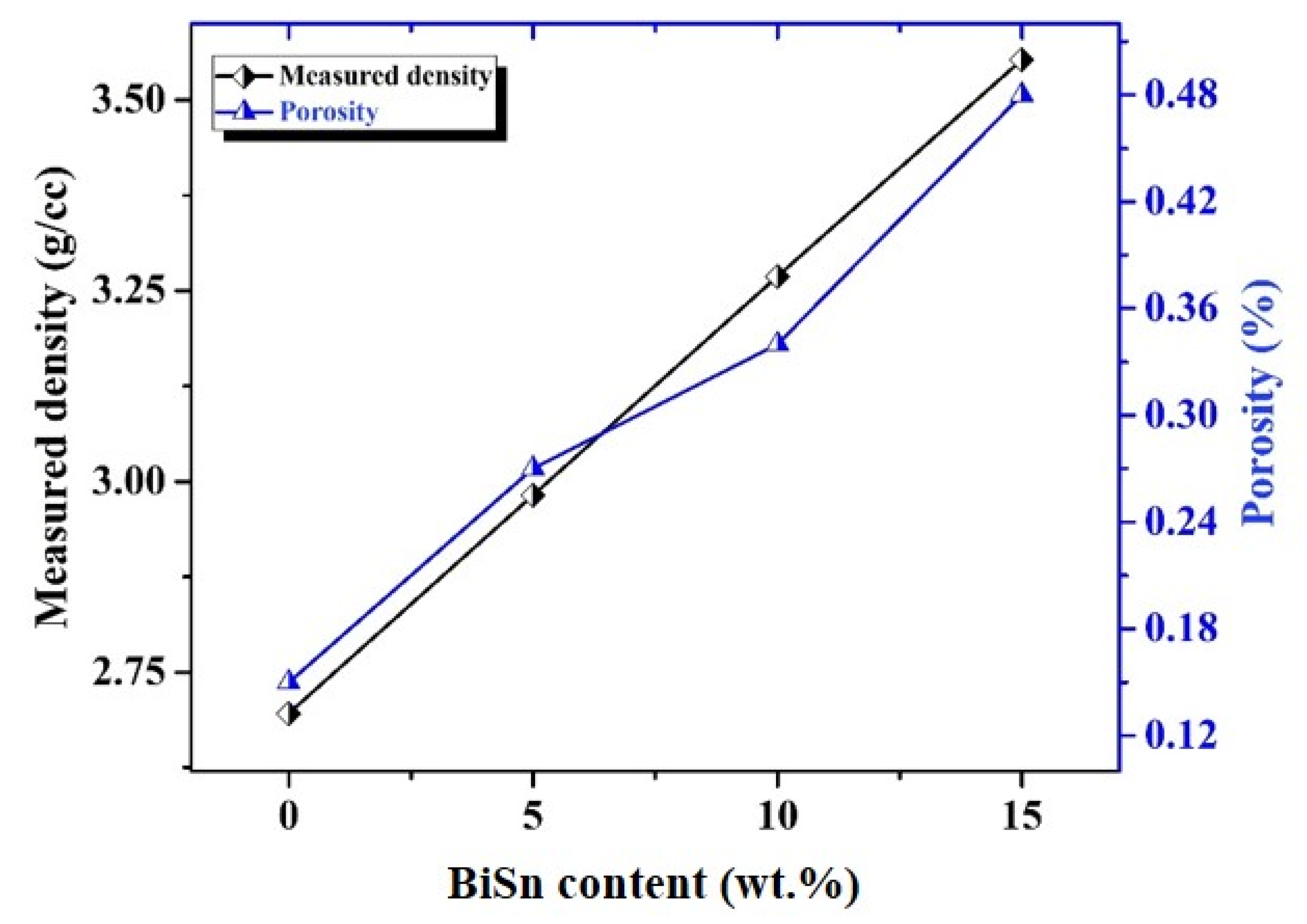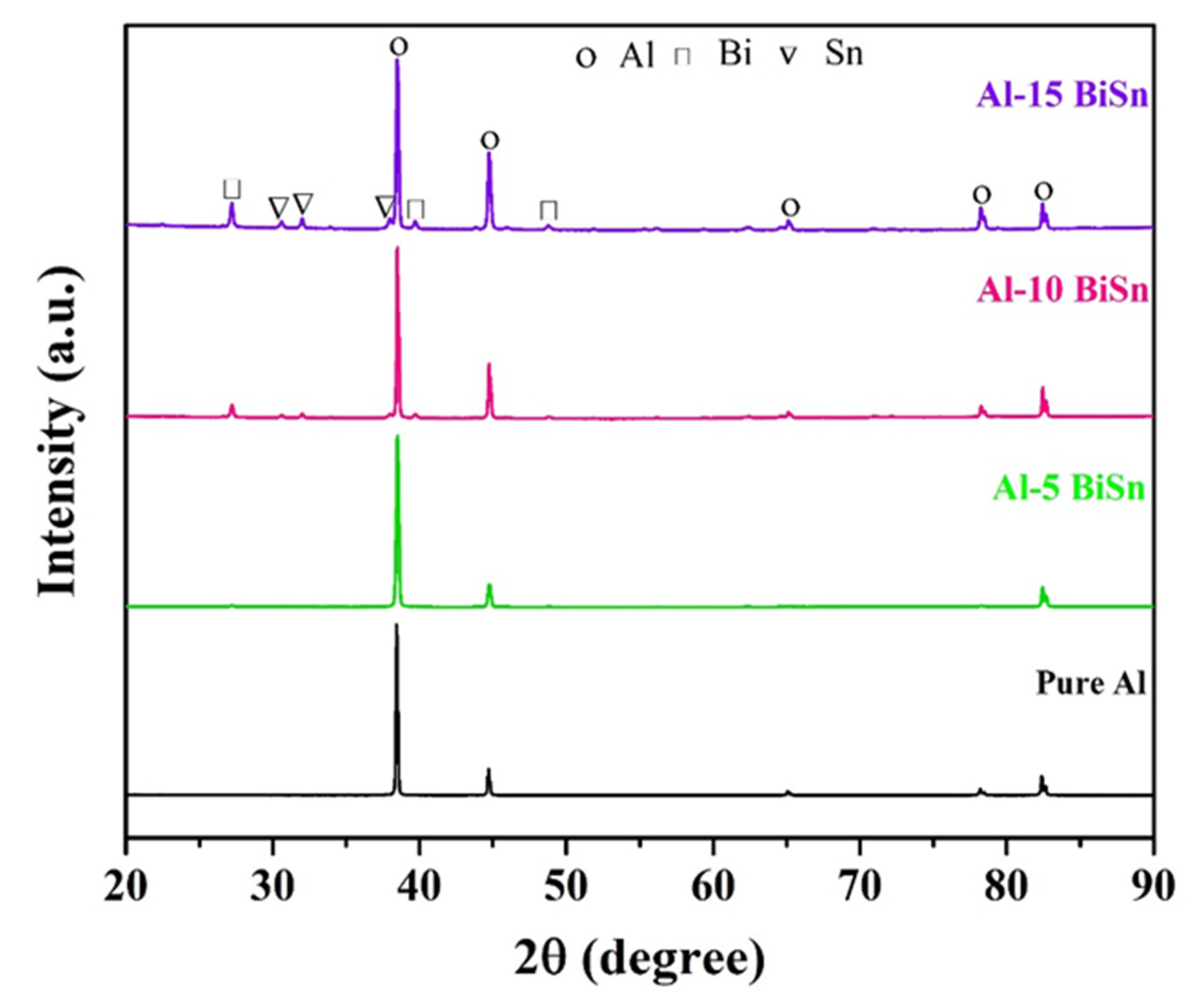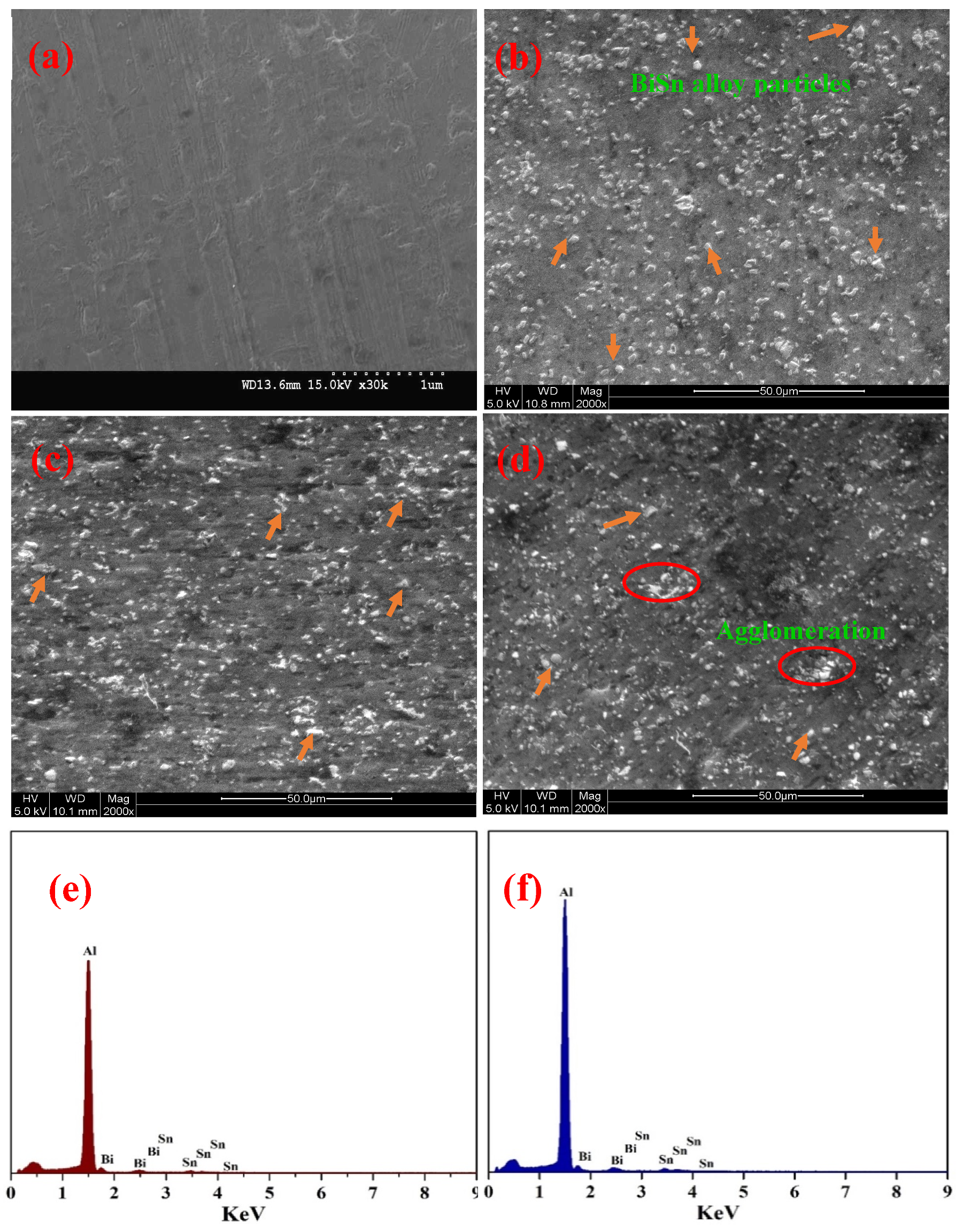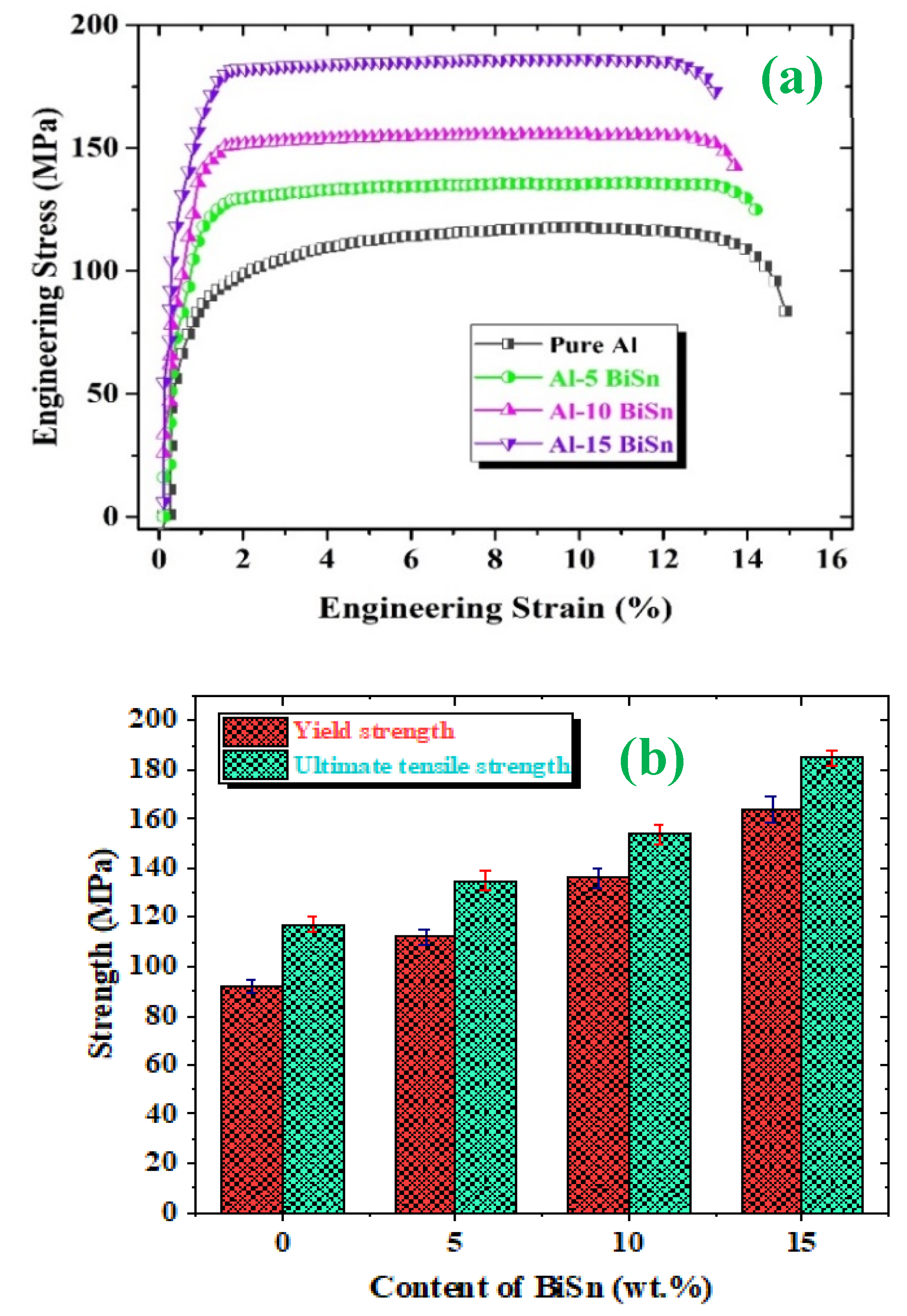Microstructure and Mechanical Behavior of Hot Extruded Aluminum/Tin-Bismuth Composites Produced by Powder Metallurgy
Abstract
:1. Introduction
2. Materials and Methods
2.1. Synthesis of Al-BiSn Composites
2.2. Secondary Processing
2.3. Characterization of the Extruded Al-BiSn Composites
3. Results and Discussion
3.1. Density and Porosity of Al-BiSn Composites
3.2. XRD Analysis of Al-BiSn Composites
3.3. Field Emission Scanning Electron Microscopy Analysis of Al-BiSn Composites
3.4. Atomic Force Microscopy Analysis of Al-BiSn Composites
3.5. Microhardness and Nanoindentation Analysis of Al-BiSn Composites
3.6. Tensile Properties of Al-BiSn Composites
3.7. Fracture Analysis of the Al-BiSn Composites
3.8. Coefficient of Thermal Expansion (CTE) of Al-BiSn Composites
4. Conclusions
Author Contributions
Funding
Acknowledgments
Conflicts of Interest
References
- Manakari, V.; Parande, G.; Gupta, M. Selective Laser Melting of Magnesium and Magnesium Alloy Powders: A Review. Metals 2016, 7, 2. [Google Scholar] [CrossRef] [Green Version]
- Manakari, V.; Parande, G.; Doddamani, M.; Gupta, M. Enhancing the Ignition, Hardness and Compressive Response of Magnesium by Reinforcing with Hollow Glass Microballoons. Materials 2017, 10, 997. [Google Scholar] [CrossRef] [PubMed] [Green Version]
- Matli, P.R.; Krishnan, A.V.; Manakari, V.; Parande, G.; Chua, B.; Wong, S.; Lim, C.; Gupta, M. A new method to lightweight and improve strength to weight ratio of magnesium by creating a controlled defect. J. Mater. Res. Technol. 2020. [Google Scholar] [CrossRef]
- Benedyk, J. Aluminum alloys for lightweight automotive structures. In Materials, Design and Manufacturing for Lightweight Vehicles; Elsevier BV: Amsterdam, The Netherlands, 2010; pp. 79–113. [Google Scholar]
- Subramanian, J.; Seetharaman, S.; Gupta, M. Processing and Properties of Aluminum and Magnesium Based Composites Containing Amorphous Reinforcement: A Review. Metals 2015, 5, 743–762. [Google Scholar] [CrossRef] [Green Version]
- Parande, G.; Manakari, V.; Kopparthy, S.D.S.; Gupta, M. A study on the effect of low-cost eggshell reinforcement on the immersion, damping and mechanical properties of magnesium–zinc alloy. Compos. Part B Eng. 2020, 182, 107650. [Google Scholar] [CrossRef]
- Thornby, J.; Verma, D.; Cochrane, R.; Westwood, A.; Manakari, V.B.; Gupta, M.; Haghshenas, M. Indentation-based characterization of creep and hardness behavior of magnesium carbon nanotube nanocomposites at room temperature. SN Appl. Sci. 2019, 1, 695. [Google Scholar] [CrossRef] [Green Version]
- Mallick, P. Advanced materials for automotive applications: An overview. In Advanced Materials in Automotive Engineering; Elsevier BV: Amsterdam, The Netherlands, 2012; pp. 5–27. [Google Scholar]
- Prasad, S.; Asthana, R. Aluminum Metal–Matrix Composites for Automotive Applications: Tribological Considerations. Tribol. Lett. 2004, 17, 445–453. [Google Scholar] [CrossRef]
- Casati, R.; Vedani, M. Metal Matrix Composites Reinforced by Nano-Particles—A Review. Metals 2014, 4, 65–83. [Google Scholar] [CrossRef]
- Chawla, K.K. Metal Matrix Composites. In Composite Materials; Springer Science and Business Media LLC: New York, NY, USA, 2019; pp. 199–249. [Google Scholar]
- Das, D.K.; Mishra, P.C.; Singh, S.; Thakur, R.K. Properties of ceramic-reinforced aluminium matrix composites—A review. Int. J. Mech. Mater. Eng. 2014, 9, 25. [Google Scholar] [CrossRef] [Green Version]
- Rajak, D.K.; Pagar, D.D.; Kumar, R.; Pruncu, C.I. Recent progress of reinforcement materials: A comprehensive overview of composite materials. J. Mater. Res. Technol. 2019, 8, 6354–6374. [Google Scholar] [CrossRef]
- Sharma, P.; Sharma, S.; Khanduja, D. A study on microstructure of aluminium matrix composites. J. Asian Ceram. Soc. 2015, 3, 240–244. [Google Scholar] [CrossRef]
- Reddy, M.P.; Ubaid, F.; Shakoor, R.A.; Parande, G.; Manakari, V.; Mohamed, A.M.A.; Gupta, M. Effect of reinforcement concentration on the properties of hot extruded Al-Al2O3 composites synthesized through microwave sintering process. Mater. Sci. Eng. A 2017, 696, 60–69. [Google Scholar] [CrossRef]
- Matli, P.; Shakoor, R.; Parande, G.; Manakari, V.; Ubaid, F.; Mohamed, A.; Gupta, M. Enhanced performance of nano-sized SiC reinforced Al metal matrix nanocomposites synthesized through microwave sintering and hot extrusion techniques. Prog. Nat. Sci. 2017, 27, 606–614. [Google Scholar]
- Reddy, M.P.; Manakari, V.; Parande, G.; Ubaid, F.; Shakoor, R.; Mohamed, A.M.A.; Gupta, M. Enhancing compressive, tensile, thermal and damping response of pure Al using BN nanoparticles. J. Alloy. Compd. 2018, 762, 398–408. [Google Scholar] [CrossRef]
- Reddy, M.P.; Himyan, M.; Ubaid, F.; Shakoor, R.A.; Vyasaraj, M.; Gururaj, P.; Yusuf, M.; Mohamed, A.; Gupta, M. Enhancing thermal and mechanical response of aluminum using nanolength scale TiC ceramic reinforcement. Ceram. Int. 2018, 44, 9247–9254. [Google Scholar] [CrossRef]
- Matli, P.R.; Ubaid, F.; Shakoor, R.A.; Parande, G.; Manakari, V.; Yusuf, M.; Mohamed, A.M.A.; Gupta, M. Improved properties of Al–Si 3 N 4 nanocomposites fabricated through a microwave sintering and hot extrusion process. RSC Adv. 2017, 7, 34401–34410. [Google Scholar] [CrossRef] [Green Version]
- Ubaid, F.; Matli, P.R.; Shakoor, R.A.; Parande, G.; Manakari, V.; Mohamed, A.M.A.; Gupta, M. Using B4C Nanoparticles to Enhance Thermal and Mechanical Response of Aluminum. Materials 2017, 10, 621. [Google Scholar] [CrossRef] [Green Version]
- Reddy, M.P.; Manakari, V.; Parande, G.; Shakoor, R.A.; Mohamed, A.M.A.; Gupta, M. Structural, mechanical and thermal characteristics of Al-Cu-Li particle reinforced Al-matrix composites synthesized by microwave sintering and hot extrusion. Compos. Part B Eng. 2019, 164, 485–492. [Google Scholar] [CrossRef]
- Matli, P.; Manakari, V.; Parande, G.; Mattli, M.; Shakoor, R.A.; Gupta, M. Improving Mechanical, Thermal and Damping Properties of NiTi (Nitinol) Reinforced Aluminum Nanocomposites. J. Compos. Sci. 2020, 4, 19. [Google Scholar] [CrossRef] [Green Version]
- Cho, S.C.; Han, C.; Choi, H.; Kim, H.S.; Jin, S.; Han, J.H. Synthesis and consolidation behavior of Al/AlN composite powders by reactive RF thermal plasma spraying. Powder Technol. 2016, 287, 395–402. [Google Scholar] [CrossRef]
- Kumar, G.; Pramod, R.; Sekhar, C.G.; Bhanumurthy, T.; Kumar, G. Investigation of physical, mechanical and tribological properties of Al6061–ZrO2 nano-composites. Heliyon 2019, 5, e02858. [Google Scholar] [CrossRef] [PubMed]
- Mohammed, H.; Reddy, M.P.; Ubaid, F.; Shakoor, R.A.; Mohamed, A.M.A. Structural and mechanical properties of CeO2 reinforced Al matrix nanocomposites. Adv. Mater. Lett. 2018, 9, 602–605. [Google Scholar] [CrossRef]
- Oke, S.R.; Falodun, O.E.; Mahlatse, M.R.; Ige, O.O.; Olubambi, P.A. Investigation on densification and microstructure of Al-TiO2 composite produced by Spark plasma sintering. Mater. Today Proc. 2019, 18, 3182–3188. [Google Scholar]
- Cavaliere, P.; Jahantigh, F.; Shabani, A.; Sadeghi, B. Influence of SiO2 nanoparticles on the microstructure and mechanical properties of Al matrix nanocomposites fabricated by spark plasma sintering. Compos. Part B Eng. 2018, 146, 60–68. [Google Scholar] [CrossRef]
- Sharma, P.; Sharma, S.; Khanduja, D. Production and some properties of Si3N4 reinforced aluminium alloy composites. J. Asian Ceram. Soc. 2015, 3, 352–359. [Google Scholar] [CrossRef] [Green Version]
- Chandra, D.; Chauhan, N.R.; Rajesha, S. Hardness and Toughness Evaluation of Developed Al Metal Matrix Composite Using Stir Casting Method; Elsevier BV: Amsterdam, The Netherlands, 2020. [Google Scholar]
- Das, J.; Chandra, K.; Misra, P.; Sarma, B. Hardness and tensile properties of Fe–P based alloys made through powder forging technique. Mater. Sci. Eng. A 2008, 479, 164–170. [Google Scholar] [CrossRef]
- C, G.M.; Hiremath, P.; Shettar, M.; Sharma, S.; U, S.R. Experimental validity on the casting characteristics of stir cast aluminium composites. J. Mater. Res. Technol. 2020. [Google Scholar] [CrossRef]
- Kane, S.N.; Mishra, A.; Gaur, A. PREFACE: International Conference on Recent Trends in Physics (ICRTP 2014). J. Phys. Conf. Ser. 2014. [Google Scholar] [CrossRef]
- Purohit, R.; Qureshi, M.; Kumar, B. Effect of Forging on Aluminum Matrix Nano Composites: A Review. Mater. Today Proc. 2017, 4, 5357–5360. [Google Scholar] [CrossRef]
- Gessinger, G.H. Recent Developments in Powder Metallurgy. Met. Sci. 1974, 8, 394–396. [Google Scholar] [CrossRef]
- Abdelaziz, S.M.; Zahran, H.; El-Rehim, A.A. Microstructure and mechanical properties of tin-bismuth solder alloy reinforced by antimony oxide nanoparticles. Int. J. Adv. Eng. Technol. 2017, 10, 73. [Google Scholar]
- Peng, Y.; Deng, K. Fabrication of reduced graphene oxide nanosheets reinforced Sn–Bi nanocomposites by electro-chemical deposition. Compos. Part A Appl. Sci. Manuf. 2015, 73, 55–62. [Google Scholar] [CrossRef]
- He, P.; Lü, X.-C.; Lin, T.; Li, H.-X.; An, J.; Ma, X.; Feng, J.; Zhang, Y.; Li, Q.; Qian, Y.-Y. Improvement of mechanical properties of Sn–58Bi alloy with multi-walled carbon nanotubes. Trans. Nonferrous Met. Soc. China 2012, 22, s692–s696. [Google Scholar] [CrossRef]
- Costa, T.; Freitas, E.S.; Dias, M.; Brito, C.; Cheung, N.; Garcia, A. Monotectic Al–Bi–Sn alloys directionally solidified: Effects of Bi content, growth rate and cooling rate on the microstructural evolution and hardness. J. Alloy. Compd. 2015, 653, 243–254. [Google Scholar] [CrossRef]
- Du Preez, S.P. Hydrogen Generation by Means of Hydrolysis Using Activated Al-In-Bi-Sn Composites for Electrochemical Energy Applications. Int. J. Electrochem. Sci. 2017, 8663–8682. [Google Scholar] [CrossRef]
- Kujur, M.S.; Mallick, A.; Manakari, V.; Parande, G.; Tun, K.S.; Gupta, M. Significantly Enhancing the Ignition/Compression/Damping Response of Monolithic Magnesium by Addition of Sm2O3 Nanoparticles. Metals 2017, 7, 357. [Google Scholar] [CrossRef] [Green Version]
- Parande, G.; Manakari, V.; Meenashisundaram, G.K.; Gupta, M. Enhancing the tensile and ignition response of monolithic magnesium by reinforcing with silica nanoparticulates. J. Mater. Res. 2017, 32, 2169–2178. [Google Scholar] [CrossRef]
- Parande, G.; Manakari, V.; Kopparthy, S.D.S.; Gupta, M. Utilizing Low-Cost Eggshell Particles to Enhance the Mechanical Response of Mg-2.5Zn Magnesium Alloy Matrix. Adv. Eng. Mater. 2017, 20, 1700919. [Google Scholar] [CrossRef]
- Kujur, M.S.; Manakari, V.; Parande, G.; Tun, K.S.; Mallick, A.; Gupta, M. Enhancement of thermal, mechanical, ignition and damping response of magnesium using nano-ceria particles. Ceram. Int. 2018, 44, 15035–15043. [Google Scholar] [CrossRef]
- Zeng, X.; Liu, W.; Xu, B.; Shu, G.; Li, Q.-L. Microstructure and Mechanical Properties of Al–SiC Nanocomposites Synthesized by Surface-Modified Aluminium Powder. Metals 2018, 8, 253. [Google Scholar] [CrossRef] [Green Version]
- Issa, H.K.; Taherizadeh, A.; Maleki, A.; Ghaei, A. Development of an aluminum/amorphous nano-SiO2 composite using powder metallurgy and hot extrusion processes. Ceram. Int. 2017, 43, 14582–14592. [Google Scholar] [CrossRef]
- Bisht, A.; Srivastava, M.; Kumar, R.M.; Lahiri, I.; Lahiri, D.; Kumar, M.R. Strengthening mechanism in graphene nanoplatelets reinforced aluminum composite fabricated through spark plasma sintering. Mater. Sci. Eng. A 2017, 695, 20–28. [Google Scholar] [CrossRef]
- Ravichandran, M.; Meignanamoorthy, M.; Dineshkumar, S. Microstructure and Properties of Hot Extruded Al-TiO2 Powder Metallurgic Composites. Appl. Mech. Mater. 2016, 852, 130–135. [Google Scholar] [CrossRef]










| Material | Hardness | Tensile Properties | |||
|---|---|---|---|---|---|
| Micro (HV) | Nano (GPa) | Yield Strength/MPa | Ultimate Tensile Strength/MPa | % of Elongation | |
| Pure Al | 36 ± 2 | 38 ± 3 | 92 ± 3 | 117 ± 3 | 13.70 |
| Al-(5 wt.% BiSn) | 49 ± 6 | 53 ± 4 | 112 ± 3 | 135 ± 4 | 13.45 |
| Al-(10 wt.% BiSn) | 62 ± 4 | 67 ± 1 | 136 ± 4 | 154 ± 1 | 12.76 |
| Al-(15 wt.% BiSn) | 78 ± 4 | 83 ± 2 | 164 ± 5 | 185 ± 3 | 12.04 |
| Al-(10 wt.% Al2O3) [15] | 73 ± 6 | - | 118 ± 5 | 141 ± 5 | 9.4 ± 0.5 |
| Al-(10 wt.% AlCuLi) [21] | 72 ± 3 | - | 122 ± 3 | 152 ± 6 | 8.3 ± 0.5 |
| Al-(3 wt.% SiC) [44] | 56.1 | - | 142 | 162 | 4.7 |
| Al-(3 wt.% SiO2) [45] | 38.7 | - | 100 | 137 | 0.9 |
| Al-(5 wt.% GNP) [46] | - | - | 22 | 27 | 0.2 |
| Al-(10 wt.% TiO2) [47] | 37 | - | 64 | 76 | 5.33 |
© 2020 by the authors. Licensee MDPI, Basel, Switzerland. This article is an open access article distributed under the terms and conditions of the Creative Commons Attribution (CC BY) license (http://creativecommons.org/licenses/by/4.0/).
Share and Cite
Khan, A.; Matli, P.R.; Nawaz, M.; Mattli, M.R.; Parande, G.; Manakari, V.; Shakoor, A.; Aljaber, A.S.; Gupta, M. Microstructure and Mechanical Behavior of Hot Extruded Aluminum/Tin-Bismuth Composites Produced by Powder Metallurgy. Appl. Sci. 2020, 10, 2812. https://doi.org/10.3390/app10082812
Khan A, Matli PR, Nawaz M, Mattli MR, Parande G, Manakari V, Shakoor A, Aljaber AS, Gupta M. Microstructure and Mechanical Behavior of Hot Extruded Aluminum/Tin-Bismuth Composites Produced by Powder Metallurgy. Applied Sciences. 2020; 10(8):2812. https://doi.org/10.3390/app10082812
Chicago/Turabian StyleKhan, Adnan, Penchal Reddy Matli, Muddasir Nawaz, Manohar Reddy Mattli, Gururaj Parande, Vyasaraj Manakari, Abdul Shakoor, Amina Sultan Aljaber, and Manoj Gupta. 2020. "Microstructure and Mechanical Behavior of Hot Extruded Aluminum/Tin-Bismuth Composites Produced by Powder Metallurgy" Applied Sciences 10, no. 8: 2812. https://doi.org/10.3390/app10082812








